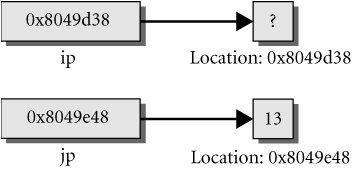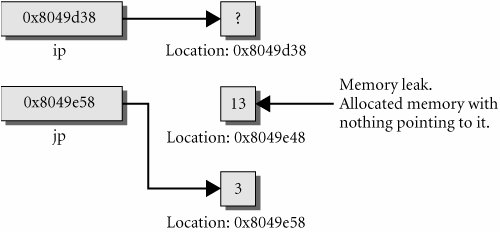Further Pointer Pathology with Heap Memory
The result of applying delete to a pointer that holds the address of a valid object in the heap is to change the status of that heap memory from "in use" to "available." After delete has been applied to a pointer, the state of that pointer itself is undefined. The pointer may or may not still store the address of that deleted memory, so a second application of delete to the same pointer may cause run-time problemspossibly heap corruption.
In general, the compiler cannot detect attempts to apply delete repeatedly to the same object, especially if that piece of memory (or a part thereof) has since been reallocated. To help avoid the very undesirable consequences of a repeated delete, it is good practice to assign NULL to a pointer immediately after it has been deleted.
If delete is applied to a null pointer, there is no action and no error.
Applying delete to a non-null pointer that was not returned by new produces undefined results. In general, the compiler will not be able to determine whether the pointer was or was not returned by new, so undefined run-time behavior can result. Bottom line: It is the programmer's responsibility to use delete correctly.
One of the richest sources of run-time errors is the production of memory leaks. A memory leak is produced when a program causes memory to be allocated and then loses track of that memory so that it can neither be accessed nor deleted. An object that is not properly deleted will occupy memory until the process terminates.
Some programs (e.g., operating systems) stay active for a long time. Suppose such a program contains a frequently executed routine that produces a memory leak each time it is run. The heap will gradually become perforated with blocks of inaccessable, undeleted memory. At some point a routine that needs a substantial amount of contiguous dynamic memory may have its request denied. If the program was not expecting an event like that, it may not be able to continue.
The operators new and delete give the C++ programmer increased power as well as increased responsibility.
Here is some sample code that illustrates a memory leak. After defining a couple of pointers, memory will look a little like Figure 22.1.
int* ip = new int; // allocate space for an int int* jp = new int(13); // allocate and initialize cout << ip << ' ' << jp << endl;
Figure 22.1. Initial values of memory

Now we add one more line of code.
jp = new int(3); // reassign the pointer - MEMORY LEAK!!
After executing the single line above, our memory looks like Figure 22.2.
Figure 22.2. Memory after leak

Example 22.3. src/pointers/pathology/pathologydemo1.cpp
#include
using namespace std;
int main() {
int* jp = new int(13); <-- 1
cout << jp << ' ' << *jp << endl;
delete jp;
delete jp; <-- 2
jp = new int(3); <-- 3
cout << jp << ' ' << *jp << endl;
jp = new int(10); <-- 4
cout << jp << ' ' << *jp << endl;
int* kp = new int(17);
cout << kp << ' ' << *kp << endl;
return 0;
}
Output:
OOP> g++ pathologydemo1.cpp
OOP> ./a.out
0x8049e08 13
0x8049e08 3
0x8049e08 10
Segmentation fault
OOP>
|
In Example 22.3, we deleted the pointer jp twice. The second deletion is a serious error but the compiler did not catch it. That error corrupted the heap, made any further memory allocation impossible, and made the behavior of the program beyond that point undefined. For example, notice that when we attempted to produce a memory leak by reassigning the pointer jp, we did not get any new memory. When we attempted to introduce another pointer variable we got a segmentation fault. This is all undefined behavior and may be different on another platform or with another compiler.
Part I: Introduction to C++ and Qt 4
C++ Introduction
- C++ Introduction
- Overview of C++
- A Brief History of C++
- Setup: Open-Source Platforms
- Setup: Win32
- C++ First Example
- Input and Output
- Identifiers, Types, and Literals
- C++ Simple Types
- C++ Standard Library Strings
- Streams
- The Keyword const
- Pointers and Memory Access
- const* and *const
- Reference Variables
- Points of Departure
- Review Questions
Classes
- Classes
- Structs
- Class Definitions
- Member Access Specifiers
- Encapsulation
- Introduction to UML
- Friends of a Class
- Constructors
- Subobjects
- Destructors
- The Keyword static
- Copy Constructors and Assignment Operators
- Conversions
- const Member Functions
- Review Questions
Introduction to Qt
- Introduction to Qt
- Example Project: Using QApplication and QLabel
- Makefile, qmake, and Project Files
- Getting Help Online
- Style Guidelines and Naming Conventions
- The Qt Core Module
- Streams and Dates
- Points of Departure
- Review Questions
Lists
Functions
- Functions
- Function Declarations
- Overloading Functions
- Optional Arguments
- Operator Overloading
- Parameter Passing by Value
- Parameter Passing by Reference
- References to const
- Function Return Values
- Returning References from Functions
- Overloading on const-ness
- Inline Functions
- Inlining versus Macro Expansion
- Review Questions
Inheritance and Polymorphism
- Inheritance and Polymorphism
- Simple Derivation
- Derivation with Polymorphism
- Derivation from an Abstract Base Class
- Inheritance Design
- Overloading, Hiding, and Overriding
- Constructors, Destructors, and Copy Assignment Operators
- Processing Command-Line Arguments
- Points of Departure
- Review Questions
Part II: Higher-Level Programming
Libraries
- Libraries
- Code Containers
- Reusing Other Libraries
- Organizing Libraries: Dependency Management
- Installing Libraries: A Lab Exercise
- Frameworks and Components
- Review Questions
Introduction to Design Patterns
QObject
- QObject
- QObjects Child Managment
- Composite Pattern: Parents and Children
- QApplication and the Event Loop
- Q_OBJECT and moc: A Checklist
- Values and Objects
- tr() and Internationalization
- Point of Departure
- Review Questions
Generics and Containers
- Generics and Containers
- Generics and Templates
- Containers
- Managed Containers, Composites, and Aggregates
- Implicitly Shared Classes
- Generics, Algorithms, and Operators
- Serializer Pattern
- Sorted Map Example
- Review Questions
Qt GUI Widgets
- Qt GUI Widgets
- Widget Categories
- QMainWindow and QSettings
- Dialogs
- Images and Resources
- Layout of Widgets
- QActions, QMenus, and QMenuBars
- QActions, QToolbars, and QActionGroups
- Regions and QDockWidgets
- Views of a QStringList
- Points of Departure
- Review Questions
Concurrency
- Concurrency
- QProcess and Process Control
- Threads and QThread
- Summary: QProcess and QThread
- Review Questions
Validation and Regular Expressions
- Validation and Regular Expressions
- Validators
- Regular Expressions
- Regular Expression Validation
- Review Questions
Parsing XML
Meta Objects, Properties, and Reflective Programming
- Meta Objects, Properties, and Reflective Programming
- Anti-patterns
- QMetaObject: The MetaObject Pattern
- Type Identification and qobject_cast
- Q_PROPERTY Macro: Describing QObject Properties
- QVariant Class: Accessing Properties
- DataObject: An Extension of QObject
- Property Containers: PropsMap
- Review Questions
More Design Patterns
- More Design Patterns
- Creational Patterns
- Serializer Pattern Revisited
- The Façade Pattern
- Points of Departure
- Review Questions
Models and Views
- Models and Views
- M-V-C: What about the Controller?
- Dynamic Form Models
- Qt 4 Models and Views
- Table Models
- Tree Models
- Review Questions
Qt SQL Classes
Part III: C++ Language Reference
Types and Expressions
- Types and Expressions
- Operators
- Evaluation of Logical Expressions
- Enumerations
- Signed and Unsigned Integral Types
- Standard Expression Conversions
- Explicit Conversions
- Safer Typecasting Using ANSI C++ Typecasts
- Run-Time Type Identification (RTTI)
- Member Selection Operators
- Point of Departure
- Review Questions
Scope and Storage Class
- Scope and Storage Class
- Declarations and Definitions
- Identifier Scope
- Storage Class
- Namespaces
- Review Questions
Statements and Control Structures
Memory Access
- Memory Access
- Pointer Pathology
- Further Pointer Pathology with Heap Memory
- Memory Access Summary
- Introduction to Arrays
- Pointer Arithmetic
- Arrays, Functions, and Return Values
- Different Kinds of Arrays
- Valid Pointer Operations
- What Happens If new Fails?
Chapter Summary
Inheritance in Detail
- Inheritance in Detail
- Virtual Pointers and Virtual Tables
- Polymorphism and virtual Destructors
- Multiple Inheritance
- Point of Departure
- public, protected, and private Derivation
- Review Questions
Miscellaneous Topics
Part IV: Programming Assignments
MP3 Jukebox Assignments
- MP3 Jukebox Assignments
- Data Model: Mp3File
- Visitor: Generating Playlists
- Preference: An Enumerated Type
- Reusing id3lib
- PlayListModel Serialization
- Testing Mp3File Related Classes
- Simple Queries and Filters
- Mp3PlayerView
- Models and Views: PlayList
- Source Selector
- Persistent Settings
- Edit Form View for FileTagger
- Points of Departure
Part V: Appendices
MP3 Jukebox Assignments
- MP3 Jukebox Assignments
- Appendix A. C++ Reserved Keywords
- Appendix B. Standard Headers
- Appendix C. The Development Environment
- Section C.1. The Preprocessor: For #including Files
- Section C.2. Understanding the Linker
- Section C.3. Debugging
- Section C.4. Qt Assistant and Designer
- Section C.5. Open-Source IDEs and Development Tools
Bibliography
MP3 Jukebox Assignments
EAN: 2147483647
Pages: 268
